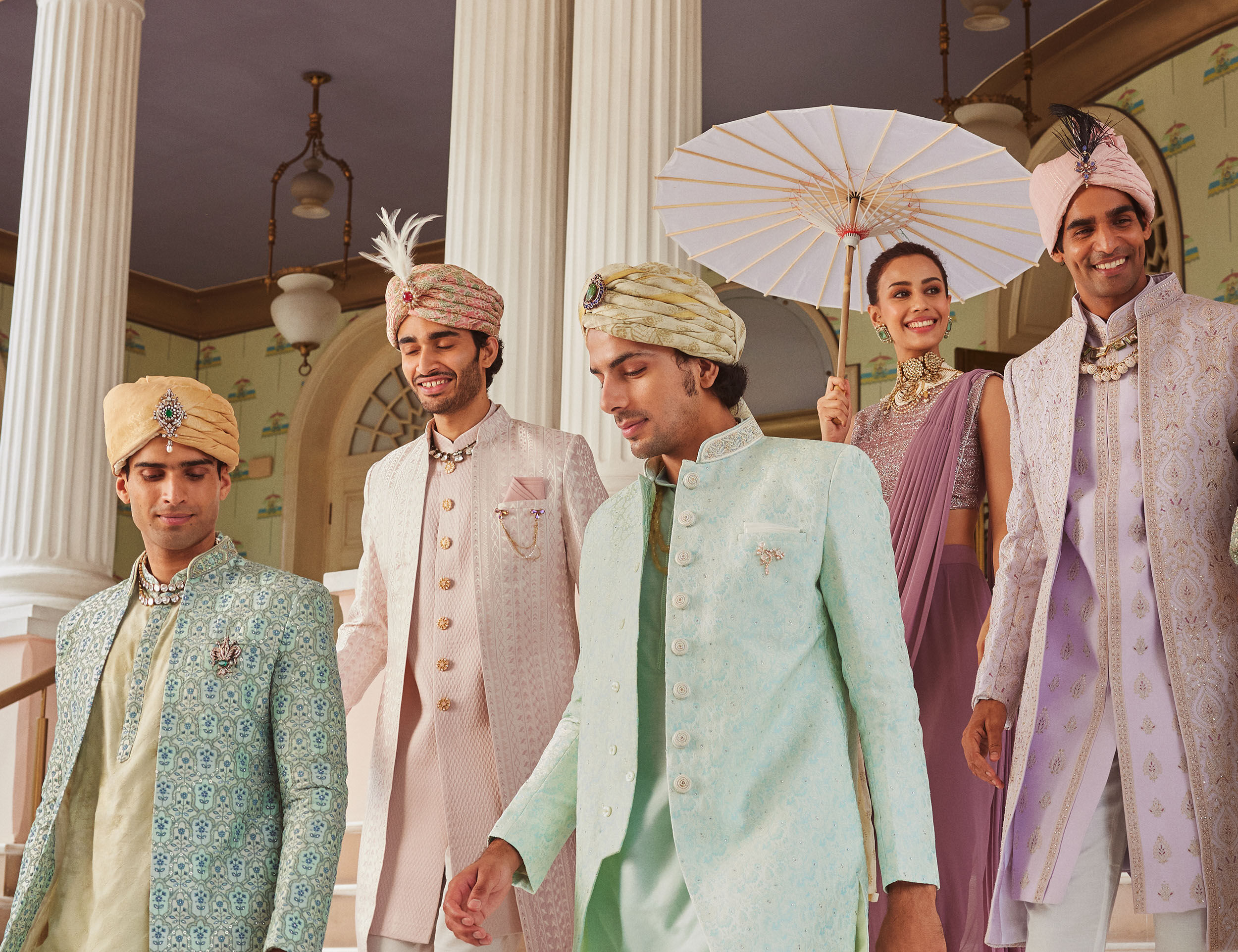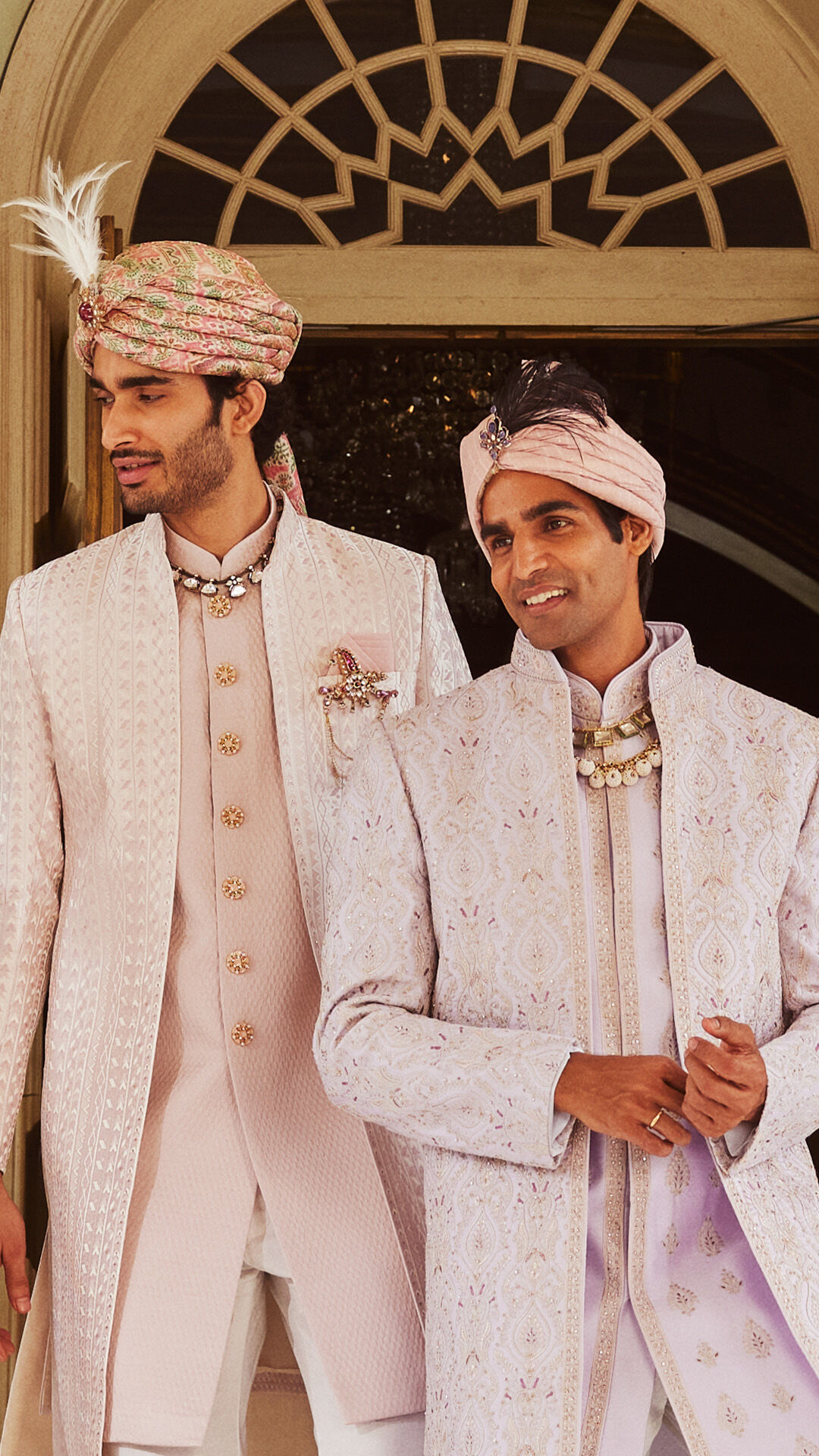STORIES BY MANYAVAR & MOHEY

Lifestyle
The Cultural Heritage of the Rajputi Safa in Weddings
Date 17 April 2025 Reading time: 7-10 mins
A burst of colour. An artful arrangement of folds. The glint of a jewelled brooch catching the light. At an Indian wedding, few sights are as majestic as a groom wearing a perfectly tied Jodhpuri royal Rajputi safa. More than just a turban, the safa is a cultural icon, a symbol of heritage and pride passed down through generations. Let's take a closer look at the rich legacy of this regal headgear and its enduring significance in Indian weddings, especially the grand celebrations of Jodhpur.
The Jodhpuri safa or Rajputi safa Jodhpuri is a traditional turban worn by men in many parts of India, particularly in the western state of Rajasthan. The art of tying a safa is an ancient skill, with different regions, communities, and even families having their own distinctive styles. But among all these variations, the Jodhpuri safa stands out for its regal elegance and rich cultural symbolism.
The Cultural Significance of the Rajputi Safa in Weddings
Jodhpur, the "Blue City" of Rajasthan, is renowned for its vibrant Rajput culture, majestic forts, and opulent royal heritage. And the Jodhpuri safa is an integral part of this legacy. Worn by Rajput nobles and royalty for centuries, this intricately tied turban is more than just a fashion statement – it's a marker of identity, status, and cultural pride.
In Rajasthani weddings, especially those in Jodhpur, the safa is an essential part of the groom's attire. A Jodhpuri groom is considered incomplete without a resplendent safa crowning his ensemble. The safa not only adds a regal touch to the groom's look but also carries deep cultural symbolism.
The colours, patterns, and adornments on a wedding safa often hold special significance. Maroon is a popular choice, as it represents vigour and passion. White stands for purity, while yellow signifies prosperity. Manyavar's stunning range of men's accessories includes Jodhpuri royal Rajputi safas in a variety of auspicious shades and designs perfect for weddings.
- The way a safa is tied also matters. Different styles are worn for different occasions, with the wedding safa being the most elaborate. A safa from Manyavar's groom collection is often adorned with precious stones, pearls, or a bejeweled brooch called a sarpech, symbolising his elevated status on this special day.
- Tying a Jodhpuri royal Rajputi safas is an art in itself, with the fabric sometimes reaching up to 8 meters in length. It's a skill passed down through generations, from father to son, with each fold and tuck holding meaning. The groom's safa is tied by a special person, usually his father or a male elder, adding to its emotional significance.
The Jodhpuri Royal Rajputi Safa: A Symbol of Royalty
Among all the regional variations of the Rajputi safa, the Jodhpuri style is considered the most regal and opulent. Steeped in the royal heritage of the Rathore dynasty, the Jodhpuri royal Rajputi safa is a symbol of nobility and grandeur.
The Making of a Jodhpuri Safa
Authentic Jodhpuri safas are crafted from the finest fabrics, often velvet or silk, in rich, vibrant colours and intricate patterns. These fabrics are frequently tie-dyed or block-printed with traditional Rajasthani motifs such as paisleys, florals, and geometric designs. The safa's border is typically enhanced with luxurious gota patti embroidery, which adds to its royal and elegant appeal, making it a sought-after accessory for weddings and formal events.
What truly sets Jodhpuri safas apart is the impeccable quality of their craftsmanship. Each safa is a work of art, painstakingly handcrafted by skilled artisans who have passed down their expertise over generations. The fabric is carefully measured, pleated, and expertly tied to achieve the perfect shape, ensuring the ideal drape and fit.
The Role of the Rajputi Safa in Jodhpuri Weddings
In a Jodhpuri royal wedding, the groom's safa is a showstopper. Often colour-coordinated with the bride's lehenga, the safa serves as a regal counterpoint to her resplendent attire. The groom's entry, or baraat, is a grand spectacle, with all eyes drawn to his majestic headgear.
The safa is not just a decorative element, but an integral part of the wedding rituals. During the sehrabandi ceremony, the groom's safa is adorned with a veil of flowers called a sehra. This marks his transition into the responsibilities of married life.
Explore Manyavar's exquisite collection of sherwanis, perfectly paired with regal Jodhpuri safas, to make a royal statement on your wedding day.
The Evolution of the Rajputi Safa Over the Years
While the Jodhpuri royal Rajputi safa is steeped in tradition, it has also evolved with the times. Today, grooms have a wider choice of fabrics, colours, and styles to choose from, allowing them to express their personal style while still honouring their heritage.
Historically, safas were made from luxurious fabrics like silk, cotton, and velvet, often in vibrant shades of maroon, saffron, and gold, reflecting the grandeur of Rajput culture. Embellishments such as intricate embroidery, mirror work, and gota patti were key to its regal appeal.
Over time, as wedding trends shifted, the safa’s design became more diverse. The incorporation of lighter, breathable fabrics, unique colours, and modern embellishments such as crystals and sequins has made the safa both stylish and versatile, blending tradition with contemporary aesthetics while retaining its cultural significance.
Modern Interpretations of the Jodhpuri Royal Rajputi Safa
Contemporary Jodhpuri safas are available in a wide variety of fabrics, ranging from classic options like silk and velvet to more modern choices such as brocade, net and georgette, especially favored for summer weddings. While traditional colours like maroon, saffron, and red remain popular choices, grooms are now embracing bolder, unconventional hues like teal, plum, and ivory, adding a unique touch to their wedding attire.
The embellishments on these safas have also evolved with the times. In addition to the classic gota patti and zardozi, modern safas now feature trendy elements like sequins, beads, and even Swarovski crystals, giving them a more contemporary and luxurious appeal. Manyavar’s collection of men’s accessories showcases a range of safas that blend traditional craftsmanship with modern aesthetics, offering something for every groom's taste.
Despite these updates, the core essence of the Jodhpuri safa remains unchanged. It continues to symbolise cultural pride, a connection to Rajasthan's royal heritage, and remains an integral part of the Indian groom’s wedding attire.
The Enduring Legacy of the Rajputi Safa
From the grand palaces of Jodhpur to the modern mandaps of today, the Rajputi safa has been a constant presence in Indian weddings. Its enduring appeal lies not just in its visual splendour, but in the rich cultural heritage it represents.
As you plan your own royal wedding, consider making the Jodhpuri safa a part of your celebration. Explore the regal collection of Rajputi safas at Manyavar to find the perfect one to crown your sherwani. Whether you choose a classic maroon silk or a contemporary printed cotton, wearing a Jodhpuri safa is a way of honouring your roots while making a regal fashion statement.
So go ahead, embrace the majestic legacy of the Rajputi safa, and let this timeless symbol of Rajasthani royalty be the crowning glory of your wedding ensemble. Aap Kab Ban Rahe Hai Manvayar!







